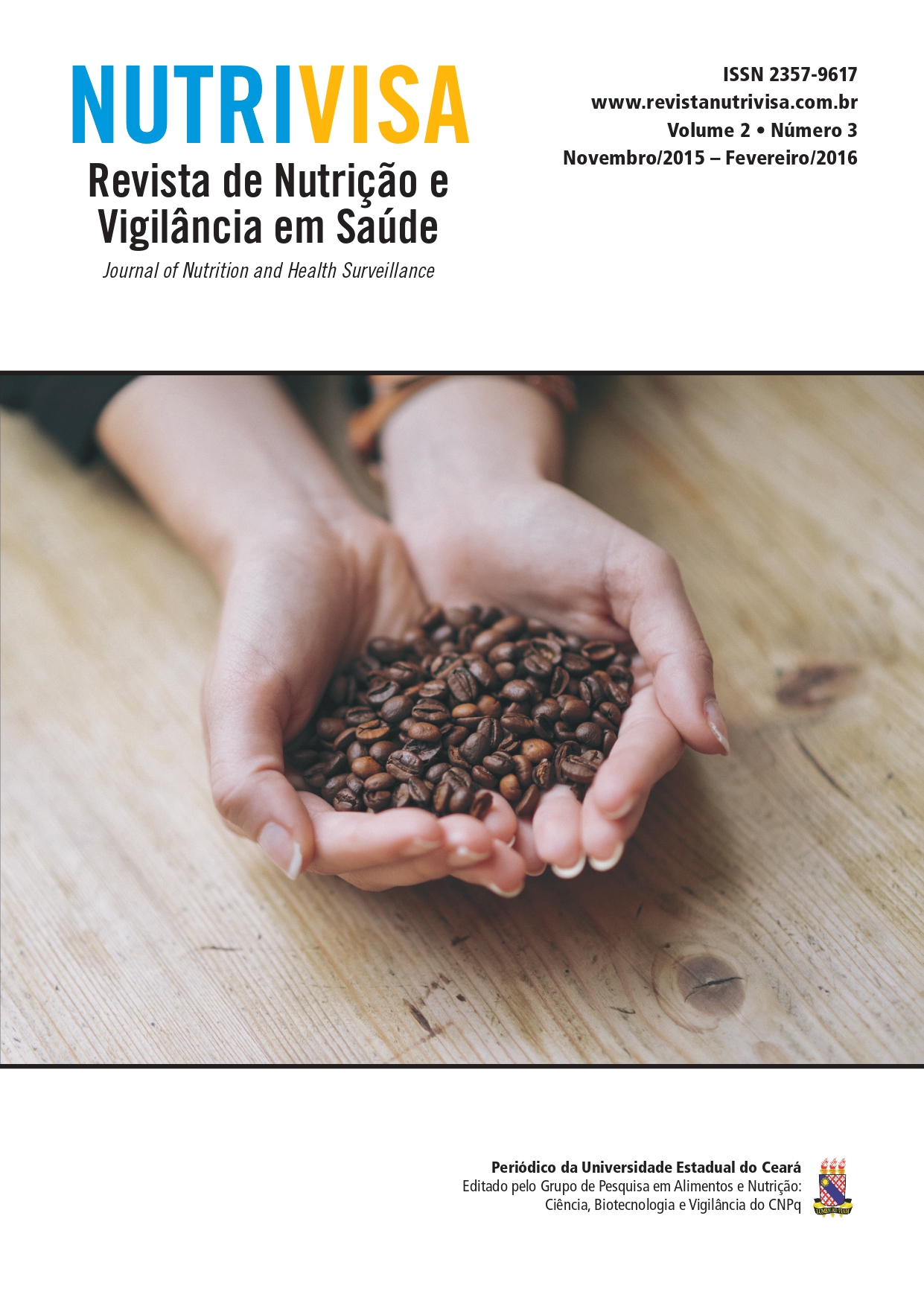Perfil sensorial de misturas de café com leite em pó e sua aceitabilidade e preferência na Região Nordeste
DOI:
https://doi.org/10.59171/nutrivisa-2015v2e9103Palavras-chave:
aceitação, análise descritiva quantitativa, análise sensorial, bebidas, caféResumo
O café é um produto de grande importância na economia mundial e novas bebidas têm sido desenvolvidas à base do grão para agradar cada vez mais o paladar dos consumidores. Neste trabalho, objetivou-se avaliar o perfil sensorial de cinco marcas comerciais de misturas de café com leite em pó e sua aceitabilidade e preferência na região Nordeste. Para tanto, foram aplicados a Análise Descritiva Quantitativa (ADQ) e testes afetivos de ordenação-preferência e aceitação global (escala hedônica), respectivamente. As amostras apresentaram perfil sensorial e aceitabilidade distintos, sendo os descritores “cor da mistura em pó”, “cor da bebida”, “odor de café”, “sabor de café” e “doçura” os mais relevantes para diferenciar as amostras. No entanto, não foi possível estabelecer os condutores de preferência, pois amostras de perfil sensorial semelhante apresentaram aceitabilidades opostas, ou seja, enquanto uma foi a preferida, a outra foi a menos preferida, enquanto amostras com mesmo nível de aceitação apresentaram perfis diferentes. Isso pode indicar que existem atributos que não foram medidos e que podem ser responsáveis pela preferência. Dessa forma, recomenda-se que, em um estudo posterior de ADQ, os descritores de sabor de café e suas notas específicas sejam mais detalhados.
Referências
ABAD. Associação Brasileira de Atacadistas e Distribuidores de Produtos Industrializados. Disponível em: <http://www.abad.com.br/ds_marcas.php>. Acesso em: 05 jul. 2015.
ABIC. Associação Brasileira das Indústrias de Café. Disponível em: <http://www.abic.com.br/publique/cgi/cgilua.exe/ sys/start.htm?sid=61#4178>. Acesso em: 05 jul. 2015.
ASTM-AMERICAN SOCIETY FOR TESTING AND MATERIALS. Guidelines for the Selection and Training of Sensory Panel Members. Philadelphia: ASTM, 1981. 77p. (STP 758)
ARRUDA, A. C.; MINIM, V. P. R.; FERREIRA, M. A. M.; MINIM, L. A.; SILVA, N. M.; SOARES, C. F. Justificativas e motivações do consumo e não consumo de café. Ciência e Tecnologia de Alimentos, v.29, n.4, p. 754-763, 2009.
CHRISTENSEN, Z. T.; OGDEN, L. V.; DUNN, M. L.; Eggett, D. L. Multiple comparison procedures for analysis of paired data. J Food Sci 71:S132-S143, 2006.
DAMASIO, M.H.; COSTELL, E. Análisis sensorial descriptivo: generación de descriptores y selección de catadores. Revista Agroquimica de Technologia de Alimentos, v. 31,n. 2, p. 165-78, 1991.
DUARTE, G. S.; FARAH, A. Effect of Simultaneous Consumption of Milk and Coffee on Chlorogenic Acids’ Bioavailability in Humans. Journal of Agricultural and Food Chemistry, v. 59, n. 14, p. 7925-7931, Mai. 2011.
DUTCOSKY, S. D. Análise Sensorial de Alimentos. 4ª ed. Curitiba: Editora Universitária Champagnat, 2013. p. 19 – 426.
GARRUTI, D. S.; BRITO, E. S.; BRANDÃO, T. M.; UCHÔA, P.; SILVA, M. A. A. P. Desenvolvimento do Perfil Sensorial e Aceitação de Requeijão Cremoso. Ciência e Tecnologia de Alimentos, Campinas, v. 23, n. 3, p. 434-440, set.-dez., 2003.
MAMEDE, M. E. O.; PERAZZO, K. K.; MACIEL, L. F.; CARVALHO, L. D. Avaliação Sensorial e Química de Café Solúvel Descafeinado. Alimentos e Nutrição, Araraquara, v. 21, n. 2, p. 311-324, abr./jun. 2010.
MEILGAARD, M.; CIVILLE, G.V.; CARR, B.T. Sensory evaluation techniques. 4ª ed. Boca Raton: CRC, 2006. 464p.
MINIM, V. P. R.; SILVA, R. C. S. N.; MILAGRES, M. P.; MARTINS, E. M. F.; SAMPAIO, S. C. S. A.; VASCONCELOS, C. M. Contribuição dos Atributos Sensoriais para Aceitabilidade de Requeijão Cremoso. Rev. Inst. Latic. “Cândido Tostes”, Viçosa: UFV, v. 372, n. 65, p. 34:42, 2010.
ORMOND, J. G. P.; PAULA, S. R. L.; FILHO, P. F. Café: (Re) Conquista dos Mercados. BNDES Setorial, Rio de Janeiro, n.10, p. 3-56, set. 1999. Disponível em: <http://www.bndes.gov.br/SiteBNDES/ export/sites/default/bndes_pt/Galerias/Arquivos/conhecimento/ bnset/set1001.pdf>. Acesso em: 04 mar. 2014.
SCHWAMBACH, S. L.; PETERSON, D. G. Reduction of stale flavor development in low-heat skim milk powder via epicatechin addition. Journal of Agricultural and Food Chemistry, v. 54, p. 502-508, 2006.
SHIRATSUCHI, H.; SHIMODA, M.; IMAYOSHI, K.; NODA, K.; OSAJIMA, Y. Volatile flavor compounds in spray-dried skim milk powder. Journal of Agricultural and Food Chemistry, v. 42, n. 4, p. 984-988, apr.,1994.
STONE, H.; SIDEL, J. L.Sensory Evaluation Practices. 2ª ed. San Diego: Academic Press, 1993. 295p.
WAKELING, I.N.; MACFIE, J.H. Designing consumer trials balanced for first and higher orders of carry-over effect when only a subset of k samples from t may be tested. Food Quality and Preference, v.6, p.299-308, 1995.
Downloads
Publicado
Como Citar
Edição
Seção
Licença
Copyright (c) 2016 Aline Broenstrup, Deborah dos Santos Garruti, Abel Franco Melo Gurgel, Ídila Maria da Silva Araújo, Antônio de Pádua Valença da Silva

Este trabalho está licenciado sob uma licença Creative Commons Attribution 4.0 International License.














